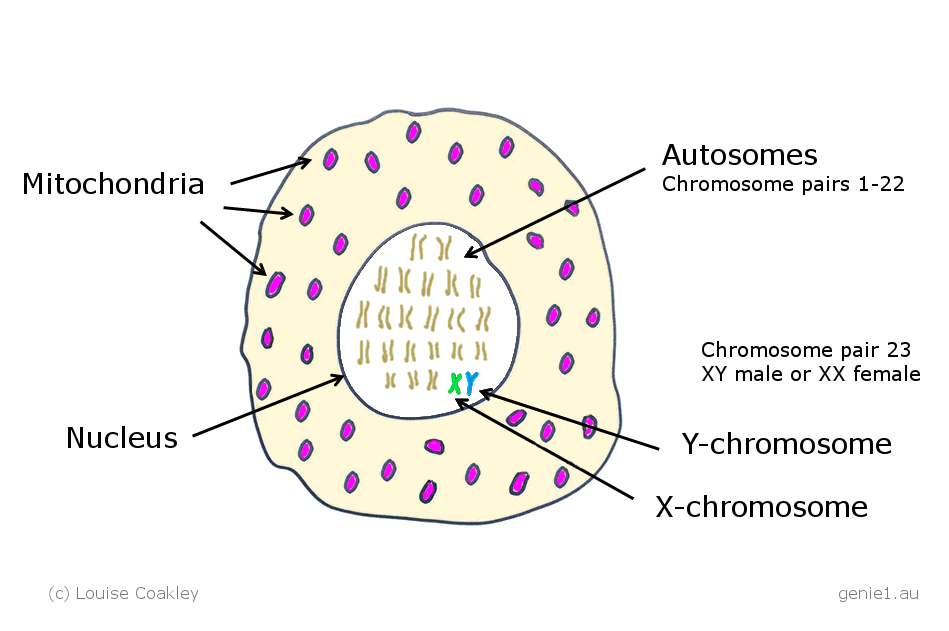For genealogical purposes, there are three main types of DNA tests that are available:
Each test type examines a different part of your DNA.

The diagram above depicts a typical human cell containing:
The pedigree chart below shows how Y-DNA, mtDNA and atDNA are inherited in your family tree:

A Y-DNA test compares a male’s y-chromosome markers with those of other males who have also tested, and will match up males with the same or very similar Y-DNA.
It is relevant to the direct paternal/male line only (generally the surname line), as per the blue boxes on the pedigree chart above – so it is ideal for use with surname projects.
Only males have Y-DNA, inherited from their father, through his father, his father, his father, etc, so only males can test for it.
A Y-DNA test can help determine if a male descends from the same male or line as another male who has tested, but generally can’t tell you ‘how’, ‘when’ or ‘where’ in your tree you match, other than on the direct paternal line.
A mitochondrial DNA test compares a person’s mtDNA with that of others who have also tested, and will match up people who share the same or very similar mtDNA.
It is relevant to the direct maternal line only, as per the pink boxes on the pedigree chart above.
Everyone has mtDNA, inherited from their mother, through her mother, her mother, her mother, etc, so anyone of any gender can test their mtDNA. Males cannot pass it on to their children, but they can test their mtDNA.
A mitochondrial DNA test can help determine if you descend from the same female ancestor as someone else who has tested, but not necessarily ‘how’, ‘when’ or ‘where’ on your family tree you share that ancestor.
An autosomal DNA test compares your autosomal DNA with the autosomal DNA of everyone else in the testing company’s atDNA database, and provides you with a list of those people you match, with estimated relationships based on the amount/percentage of shared DNA.
Autosomal DNA tests include FTDNA’s Family Finder, 23andMe, AncestryDNA, MyHeritage DNA, and matching is coming soon to Living DNA too!
Autosomal DNA testing can match you with relatives on ALL your ancestral lines – including the brown, pink and blue boxes in the pedigree chart above.
Everyone inherits autosomal DNA – directly from their parents – containing a random mix of DNA segments passed down from their grandparents, great-grandparents, great-great-grandparents, etc… so anyone of any age or gender can be tested.
Matches are the strongest and most accurate for recent generations and immediate family, but matches can be found up to 6 generations back (and sometimes further).
Autosomal DNA test results at some of the testing companies also include X-chromosome matches (you don’t need a separate X-DNA test).
X-DNA matches can be very useful, as specific inheritance patterns apply to the X-chromosome. Males can only inherit an X-chromosome from their mothers, whereas females can inherit some X recombined from both parents.
Identifying DNA relatives as X-matches can help isolate your shared common ancestor to particular branches of your tree, limiting the breadth of your research to find the connection.
Admixture: Autosomal DNA tests also include a prediction of your biogeographical makeup (also known as ‘admixture’ or ethnicity estimates), including maps of your ancestral population clusters/regions and estimated percentages.
These are generally accurate at the broad continent level, but can vary at the sub-regional levels. As the reference databases are developed and updated (adding more detailed regions and more or better population samples for existing regions), your results will be updated automatically.
Each of the testing companies presents their reports slightly differently, often at different levels of confidence, different regional breakdowns and over different time periods.

There are numerous resources that cover the above topics in more detail, including websites, video recording, blogs and books.
Refer to the DNA Links tab above for some of the easiest-to-understand resources.